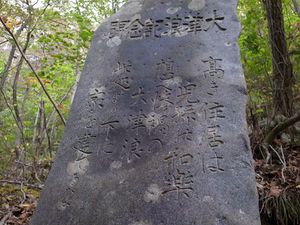File:Tsunami Warning Stone
No file by this name exists.
Tsunami Warning Stone or Tsunami stone may refer to a stone monument that indicates the highest level of other reached at tsunami, in order to warn the future generations.
The writhing is believed to be somethinf like
Beware of tsunami. Do not build homes below this level.
However, this is only guess, as the original text written in the stone is not typed.
Several authors suggest images of various Tsunami Warning Stones.
However, usually, the authors do not provide the most important indofmation about the stones shown in their pictures:
1. The authors do not type the original text written in the stones
2. The authors to not indicate the coordinates of the place, where the Tsunami Warning Stone is located.
These two observation repeat in many publications and can be considered as surely observed phenomenon.
Origin of this phenomenon can be subject of the scientific research. It is difficult to guess a honest reason, why an author (or the censor) would omit the most important information from the description of the image/
References
- ↑ https://www.smithsonianmag.com/smart-news/century-old-warnings-against-tsunamis-dot-japans-coastline-180956448/ Danny Lewis. These Century-Old Stone “Tsunami Stones” Dot Japan’s Coastline. “Remember the calamity of the great tsunamis. Do not build any homes below this point.” AUGUST 31, 2015. At the edge of Aneyoshi, a small village on Japan’s northeastern coast, a 10-foot-tall stone tablet stands, carved with a dire warning to locals. "High dwellings are the peace and harmony of our descendants," the rock slab says. "Remember the calamity of the great tsunamis. Do not build any homes below this point."// While the Aneyoshi tablet might be the most straightforward, so-called “tsunami stones” dot Japan’s coastline, warning the carvers’ descendants to seek high ground after earthquakes in case they foreshadow destructive waves. The stones vary in degrees of repair, with most dating back to around 1896, when two deadly tsunamis killed about 22,000 people, Martin Fackler writes for The New York Times. //
File usage
There are no pages that use this file.
